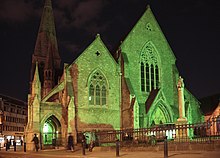St. Andrew's Church (St. Andrew's Street, Dublin)
Coordinates: 53 ° 20 '36.8 " N , 6 ° 15' 39.7" W.
The St. Andrew's Church ( Irish Eaglais San Aindrias ) at St. Andrew Street, Dublin , Republic of Ireland is a former parish church of the Church of Ireland . Today it houses the Central Tourist Office.
The church
The original St. Andrew's Church was on what is now Dame Street , but disappeared during the reign of Oliver Cromwell in the mid-17th century. In 1665, a little further away from the city walls, near Thingmote, the old meeting place of the Norman rulers, a new church was built according to the plans of William Dodson. Because of its shape, the church was known as the "Round Church". Dublin landowners such as Lord Anglesey (after whom Anglesey Street is named) and Sir John Temple (after whom Temple Bar is named) were among the church leaders of St. Andrew's Church.
The church was renovated in 1793, burned down in 1860, after which the current church was built.
The parish
The parish of St. Andrew served the civic parish of St. Andrews. In 1901 there were 3,058 believers, in 1971 there were 300.
Funerals
Esther Vanhomrigh was buried in the church in June 1723.
Marmaduke Coghill , Member of Parliament for Dublin University District, Royal Court Justice and Chancellor of the Exchequer, was buried in the family vault in 1738.
The cemetery
City councilor Thomas Pleasants, father of the merchant, builder and philanthropist Thomas Pleasant, was buried in the church cemetery in 1729.
literature
- John Gilbert: A History of the City of Dublin . Oxford University, Oxford 1854.
- An Historical Guide to the City of Dublin ( Memento of February 14, 2012 in the Internet Archive )
Individual evidence
- ^ Maurice Craig: Dublin: 1660-1860 . Allen Figgis & Co Ltd, Dublin 1969, p. 39.
- ↑ John James M'Gregor: Picture of Dublin . CP Archer, Dublin 1821, p. 96.
- ↑ 1979 census ( page no longer available , search in web archives ) Info: The link was automatically marked as defective. Please check the link according to the instructions and then remove this notice.
- ^ Francis Elrington Ball: A History of the County Dublin . unknown publisher, Dublin 1920.
- ↑ Thomas Pleasants
